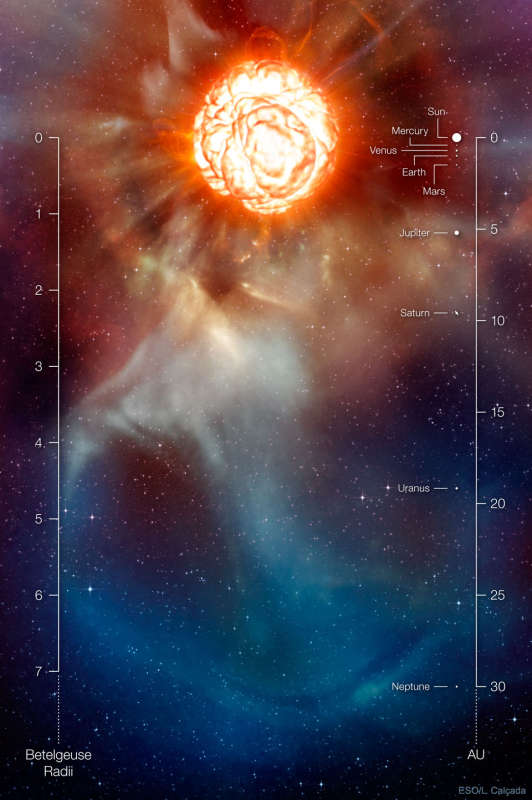Credit & Copyright: ESO,
L. Calcada
Explanation:
Why is Betelgeuse fading?
No one knows.
Betelgeuse,
one of the brightest and
most recognized stars
in the night sky, is only
half as bright as it used to be only five months ago.
Such variability is likely just
normal behavior for this famously variable
supergiant,
but the recent dimming has rekindled discussion on how long it may be before
Betelgeuse
does go supernova.
Known for its red color,
Betelgeuse is one of the few stars to be
resolved by modern telescopes, although only barely.
The
featured artist's illustration
imagines how
Betelgeuse might look up close.
Betelgeuse
is thought to have a
complex and
tumultuous surface that frequently throws impressive flares.
Were it to replace the Sun
(not
recommended), its surface would extend out near the orbit of
Jupiter, while gas plumes would bubble out past
Neptune.
Since
Betelgeuse
is about 700 light years away,
its eventual supernova will not endanger life on Earth
even though its brightness
may rival that of a full Moon.
Astronomers -- both amateur and professional -- will surely
continue to monitor
Betelgeuse as this new decade unfolds.
Free Presentation:
APOD Editor to show best astronomy images of 2019 -- and the decade -- in NYC on
January 3
1999 2000 2001 2002 2003 2004 2005 2006 2007 2008 2009 2010 2011 2012 2013 2014 2015 2016 2017 2018 2019 2020 2021 2022 2023 2024 2025 |
Yanvar' Fevral' Mart Aprel' Mai Iyun' Iyul' Avgust Sentyabr' Oktyabr' Noyabr' Dekabr' |
NASA Web Site Statements, Warnings, and Disclaimers
NASA Official: Jay Norris. Specific rights apply.
A service of: LHEA at NASA / GSFC
& Michigan Tech. U.
|
Publikacii s klyuchevymi slovami:
Betelgeuse - Betel'geize
Publikacii so slovami: Betelgeuse - Betel'geize | |
Sm. takzhe:
Vse publikacii na tu zhe temu >> | |
